 |
 |
|
|
 |
|
Since its founding more
than fifty years ago, the
American Research Center
in Egypt (ARCE) has been
dedicated to fostering
deeper knowledge and
understanding of the
history, culture and
civilization of Egypt,
from prehisotric times
through the present, and
to strengthening the
cultural and academic
links between institutions
and individuals in the
United States and Egypt.
To achieve its aims, ARCE
supports conservation and
historic preservation
projects as well as
academic and field
research in archaeology,
anthropology and
sociology.
On this page, we offer
four ARCE conservation
projects that exemplify
the organization's
historic preservation and
conservation
accomplishments. Please
click project titles below
to learn more.
|
|
Quseir
Fort
The conservation of
Quseir Fort in 1997-1999
and the creation of the
Visitors' Center was a
collaborative project
carried out in cooperation
with the Supreme Council
of Antiquities by the
American Research Center
in Egypt under a grant
from the United States
Agency for International
Development.
Egypt's Gateway
to the East
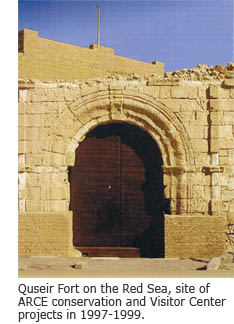 For
thousands of years, the
coasts of Egypt have acted
as the interface between
the Nile Valley and the
outside world, with points
of entry and exit, lines
of defense and sources of
raw materials and food. For
thousands of years, the
coasts of Egypt have acted
as the interface between
the Nile Valley and the
outside world, with points
of entry and exit, lines
of defense and sources of
raw materials and food.
During the Pharaonic
period, ships like those
depicted in Queen
Hatshepsut's temple at
Deir el-Bahri, Luxor, put
in at the natural harbors
at the Wadi Gassus near
Safaga laden with exotic
East African produce from
Punt. Under the Ptolemaic
and Roman governments,
Egypt was at the center of
a network of routes
connecting Europe through
Alexandria to the red Sea,
the Indian Ocean and
beyond. Quseir el-Qadim,
eight kilometers north of
the modern town, was one
of the crucial ports in
the Roman commercial
empire from the first
century BC until about AD
300.
The city was then
abandoned for nearly seven
hundred years, but it was
revived when trade with
India and southeast Asia
resumed in the Middle
Ages. Imported goods found
in excavations at Quseir
el-Qadim included Chinese
porcelain, silkworm
cocoons, peppercorns, and
mahogany timbers.
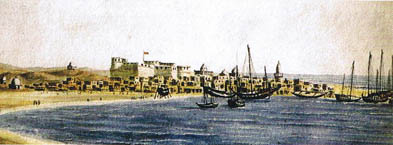
By the mid-sixteenth
century, the Indian Ocean
was controlled by the
Portuguese. In 1540, Don
Juan de Castro, a
Portuguese swashbuckler
later appointed governor
of India, sailed up the
Red Sea firing his cannon
at every coastal town on
the way, including Quseir.
This, together with the
silting up of the harbour,
caused the end of Quseir
El-Qadim. The new town,
the present-day Quseir,
became the main harbor
linking Egypt with Arabia.
The Fort
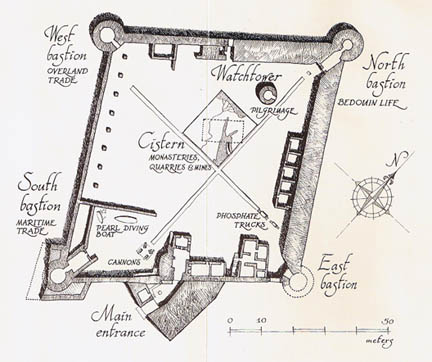 Quseir
Fort was founded in 1571.
It is mentioned in a
letter written at Quseir
in 1589 and sent to Qasr
Ibrim on the Nile in
Nubia, where it was found.
After Ottoman Turks
conquered Egypt in 1517,
they built forts and
garrisoned them with
troops along the Nile
Valley, in the deserts,
and on the coasts. An
important reason was to
defend the Red Sea against
the Portuguese and to
protect Muslim pilgrims
who embarked at Quseir for
the cities of Mecca and
Medina. The Turkish
garrison probably stayed
until the early eighteenth
century, by which time
contemporary travelers
record that the fort was
falling down. Quseir
Fort was founded in 1571.
It is mentioned in a
letter written at Quseir
in 1589 and sent to Qasr
Ibrim on the Nile in
Nubia, where it was found.
After Ottoman Turks
conquered Egypt in 1517,
they built forts and
garrisoned them with
troops along the Nile
Valley, in the deserts,
and on the coasts. An
important reason was to
defend the Red Sea against
the Portuguese and to
protect Muslim pilgrims
who embarked at Quseir for
the cities of Mecca and
Medina. The Turkish
garrison probably stayed
until the early eighteenth
century, by which time
contemporary travelers
record that the fort was
falling down.
In 1799, during
Napoleon's occupation of
Egypt, French troops
modernized and
strengthened the fort. The
impressive thickening of
the outer walls to absorb
cannon fire and the new
artillery bastion around
the south tower show the
scale of this work, even
though it was left
unfinished.
Quseir saw action in
defense of the French
occupation when two
British warships, HMS Fox
and HMS Daedalus,
bombarded the fort from
the harbor. Failing to
dislodge the defenders,
they mounted an
unsuccessful landing party
and then retreated.
During the 1820s and
1830s, Muhammad Ali Pasha
and his successor Ibrahim
repaired the fort and used
it as a staging post in
their Arabian wars. After
this, it remained in use
by the Egyptian army and
coast guard until the
1960s. Now the fort is
open for tourists to
visit, complete with
signage, panels explaining
the use of parts of the
fort, a fishing boat
exhibit and the
opportunity to climb up
the ramparts.
Back to
top
The
Cairo Mapping Project
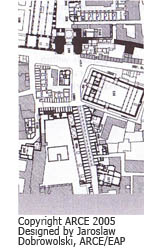 The
Cairo Mapping Project has
produced a large-scale map
of the 5.8 square
kilometers area (more than
1,400 acres) that includes
most of the historic
monuments of the city. All
listed historic buildings
and more than a hundred
unlisted ones are shown in
ground plan. Descriptions
of all the historic
buildings shown on the
map, and a list of
bibliographical references
for each one are included.
The complete map was
published in 2005. The map
will result not only in
lasting records of
cultural heritage, but
will also provide
important research and
planning tools for
historians, architects and
urban designers, among
others. The
Cairo Mapping Project has
produced a large-scale map
of the 5.8 square
kilometers area (more than
1,400 acres) that includes
most of the historic
monuments of the city. All
listed historic buildings
and more than a hundred
unlisted ones are shown in
ground plan. Descriptions
of all the historic
buildings shown on the
map, and a list of
bibliographical references
for each one are included.
The complete map was
published in 2005. The map
will result not only in
lasting records of
cultural heritage, but
will also provide
important research and
planning tools for
historians, architects and
urban designers, among
others.
Back to
top
|
|
Egyptian
Museum Database
Development
One of ARCE’s most recent
partnership initiatives
with Egypt’s Ministry of
State for Antiquities
(MSA) (formerly the
Supreme Council of
Antiquities (SCA)) is the
creation and training of
the first-ever registrar’s
department at the Egyptian
Museum in Cairo. Unlike
many of the world’s
premier museums, among
which it can undoubtedly
be counted, the Egyptian
Museum has never had an
official registrar’s
department and has largely
relied on decades-old
methods of cataloguing and
tracking its vast
collection of artifacts.
For two centuries,
acquisitions were
hand-written in giant
ledger books known as the
"Journal d’Entrée."
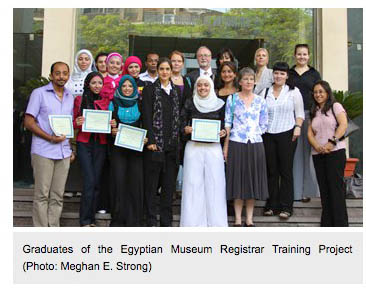 With
funding from the United
States Agency for
International Development
(USAID) as well as
planning and
implementation grants from
the Andrew W. Mellon
Foundation, ARCE and the
SCA embarked on a program
to modernize and
streamline the Egyptian
Museum’s collection
management procedures
while also training its
new registrars in standard
museum practices, such as
acquisition, cataloging,
tracking object movement
and location, condition
reporting, object
handling, inventory,
preventive care, loans and
appropriate documentation. With
funding from the United
States Agency for
International Development
(USAID) as well as
planning and
implementation grants from
the Andrew W. Mellon
Foundation, ARCE and the
SCA embarked on a program
to modernize and
streamline the Egyptian
Museum’s collection
management procedures
while also training its
new registrars in standard
museum practices, such as
acquisition, cataloging,
tracking object movement
and location, condition
reporting, object
handling, inventory,
preventive care, loans and
appropriate documentation.
The new Registration,
Collections Management,
and Documentation
Department (RCMDD) of the
Egyptian Museum, created
and trained under the
auspices of this project,
now has nine permanent
staff members operating a
fully functioning
collections management
system.
The registrars, with the
assistance of the ARCE
staff, are now carrying
out a full inventory of
the museum’s objects,
tracking object movements,
handling much of the work
of in-house exhibitions
and outgoing loans and
fielding requests for
object information and
reference images from
museum and MSA staff as
well as from scholars and
students. After the
break-ins at the museum
during the revolution, the
registrars and database
played a crucial role in
determining which items
were missing.
Back
to top
|
|
Sabil-Kutab
Muhammad 'Ali
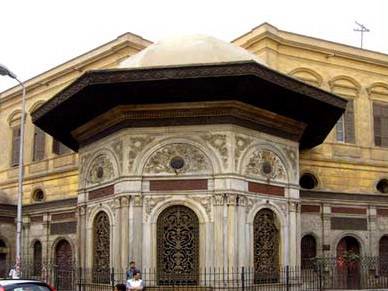 In
a hot and arid land like
Egypt, access to water is
a basic need. Provision of
water for travelers and
neighbors alike is
considered a gesture of
hospitality, from the time
of Ancient Egypt onward.
Without central water
piping in Cairo before
1900, wealthy men and
women endowed neighborhood
water taps known as
sabils. These varied in
architectural magnificence
with the wealth of the
donor and often provided
an upstairs room for a
very basic school as well. In
a hot and arid land like
Egypt, access to water is
a basic need. Provision of
water for travelers and
neighbors alike is
considered a gesture of
hospitality, from the time
of Ancient Egypt onward.
Without central water
piping in Cairo before
1900, wealthy men and
women endowed neighborhood
water taps known as
sabils. These varied in
architectural magnificence
with the wealth of the
donor and often provided
an upstairs room for a
very basic school as well.
This sabil was
established in 1820 by
Muhammad 'Ali Pasha in
commemoration of his son
Tusun. The bow-fronted
building is lavishly
decorated in marble, wood
and gilded bronze. It is
covered by a wooden dome
decorated with paintings
inside. Its style is an
example of transition from
traditional Ottoman
achritecture of Cairo to
the buildings of Muhammad
'Ali's period, which is
based more directly on the
imperial style of
Istanbul. The development
of the attached school
building reflected the
transition from a
traditional Quranic
elementary school, or
kuttab, to a modern
school.
The ARCE preservation
project started in
September 1998. After
structural and
conservation work in the
monument had been
completed, the building
was adapted for housing a
permanent educational and
interpretative exhibition.
The installation of the
exhibit was completed in
June 2004; the monument is
now open to the public.
Back
to top
|
|
Bab
Zuwayla
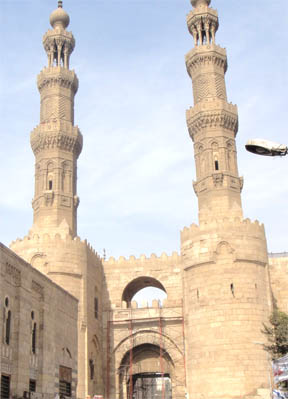 This
important historic
structure is the
monumental southern
fortified gateway of the
Fatimid city of Cairo. It
was constructed in 1087-92
of ashlar masonry. In
1415-20, Sultan Mu'ayyad
Shaykh built the adjacent
mosque to the west and
added tall minarets to the
two rounded towers of Bab
Zuwayla. This
important historic
structure is the
monumental southern
fortified gateway of the
Fatimid city of Cairo. It
was constructed in 1087-92
of ashlar masonry. In
1415-20, Sultan Mu'ayyad
Shaykh built the adjacent
mosque to the west and
added tall minarets to the
two rounded towers of Bab
Zuwayla.
After an extensive
preparatory and
documentation phase in
1995-97, on-site work
started in May 1998. The
conservation of the wooden
gates, towers and minarets
was finished in April
2002, and the monument
opened to the public in
September 2003, complete
with a self-guided
exhibit.
Back to
top
|
|
Karnak and
Luxor Temple Conservation
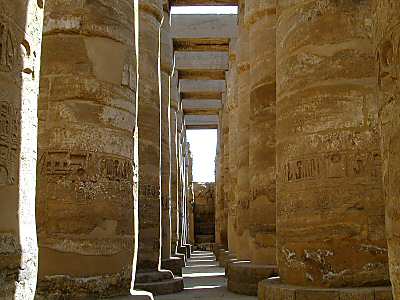 The
Karnak and Luxor temple
complexes on the East Bank
of the Nile at Luxor are,
without a doubt, iconic
symbols of ancient Egypt.
Yet, rising ground water
has, until recently, been
slowly destroying these
sites. In 2006, USAID
(United States Agency for
International Development)
funded a groundwater
lowering project at the
two temple complexes. Now,
with a new multi-million
dollar USAID grant add-on
to the Egyptian
Antiquities Conservation
Program (EAC), ARCE has
begun an essential
monitoring and
conservation project at
the two temple complexes. The
Karnak and Luxor temple
complexes on the East Bank
of the Nile at Luxor are,
without a doubt, iconic
symbols of ancient Egypt.
Yet, rising ground water
has, until recently, been
slowly destroying these
sites. In 2006, USAID
(United States Agency for
International Development)
funded a groundwater
lowering project at the
two temple complexes. Now,
with a new multi-million
dollar USAID grant add-on
to the Egyptian
Antiquities Conservation
Program (EAC), ARCE has
begun an essential
monitoring and
conservation project at
the two temple complexes.
Begun in April 2007, the
project calls for the
monitoring of the east
bank temples’ structural
integrity as the water
recedes from the
foundations, the active
conservation of damaged
blocks, the construction
of a conservation
laboratory for the use of
conservation staff of
Egypt’s Supreme Council of
Antiquities (SCA), a
training program for
Egyptian conservators who
will be maintaining the
sites into the future,
investigation and
intervention at the Sacred
Lake of the Karnak Temple
and the Sacred Lake of the
Temple of Mut at Karnak,
and cleaning the remaining
painted relief sculpture
of Ramesses IV in the
Temple of Khonsu at
Karnak. All work within
the Karnak Temple
enclosure walls is being
conducted in concert with
the SCA, the
Franco-Egyptian Center,
Chicago House of the
University of Chicago, The
Brooklyn Museum, and the
Johns Hopkins University.
Back to
top
|
|
Monastery
of St. Anthony, Monastic
Cell Conservation
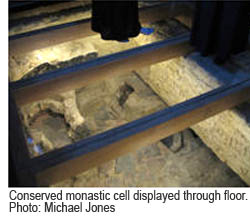 In
2004, renovations at this
working monastery on the
Red Sea coast unearthed
remains of an earlier
church and monastic cells
beneath a 14th-century
church floor.
Archaeological recording
and conservation work was
subsequently carried out,
and in 2008 a glass floor
was installed over the
conserved remains and
interior lighting was
fitted to create a display
space below the floor of
the present-day church. An
information panel about
the display, in English
and Arabic, was created in
early 2009. In
2004, renovations at this
working monastery on the
Red Sea coast unearthed
remains of an earlier
church and monastic cells
beneath a 14th-century
church floor.
Archaeological recording
and conservation work was
subsequently carried out,
and in 2008 a glass floor
was installed over the
conserved remains and
interior lighting was
fitted to create a display
space below the floor of
the present-day church. An
information panel about
the display, in English
and Arabic, was created in
early 2009.
The monastery is a
popular destination for
both foreign tourists and
Egyptian pilgrims with an
interest in the lives of
the ancient monks who
first populated the
desert. This means of
preservation and display
is an innovative example
of site management that
enables both secular and
religious visitors to see
from above the early
monastic remains preserved
below.
Back to
top
|
|
New
Book Chronicles Decade
of Conservation Work in
Egypt
In 1992, a serious
earthquake damaged many
historic buildings around
Egypt. In response, the
United States Agency for
International Development,
upon the authority of the
U.S. Congress, provided
funding for a
first-of-its-kind program
of historic preservation
and conservation to
address the needs of the
damaged antiquities. The
American Research Center
in Egypt was chosen to
administer the Egyptian
Antiquities Project (EAP)
and began work on the
first projects in 1995.
Over the next ten years
ARCE, with support from
the American people
through USAID, and in
collaboration with Egypt’s
Supreme Council of
Antiquities, oversaw more
than 50 projects that
helped to preserve Egypt’s
rich and world-renowned
legacy of cultural
heritage. Both Egyptian
and foreign experts worked
side by side on projects
ranging from pre-history
to the Ottoman period.
The achievement of these
partnerships is detailed
in a new book, "Preserving
Egypt's Cultural Heritage:
Conservation Work by the
American Research Center
in Egypt 1995-2005,"
edited by Randi Danforth.
The Hon. Margaret Scobey,
the US Ambassador to
Egypt, hosted a reception
at the Ambassador’s
residence in Cairo on
February 10, 2010
celebrating the book’s
release.
"The U.S. Embassy in
Egypt is very happy to
share in the celebration
of the publication of a
wonderful book marking ten
years of work undertaken
by the American Research
Center in Egypt (ARCE)
with the support of the
U.S. Agency for
International Development
and the Supreme Council of
Antiquities," the
Ambassador said in her
remarks. "As both partners
and neighbors, the U.S.
Embassy and ARCE have
worked together to foster
a strong relationship and
exchange of knowledge
between the United States
and Egypt."
Through stunning
photography and detailed
essays, Preserving Egypt’s
Cultural Heritage records
the important first decade
of the on-going
collaboration between
USAID, the SCA, and ARCE
to preserve Egypt’s
historic monuments and to
provide training for
Egyptian antiquities
personnel.
About the Book
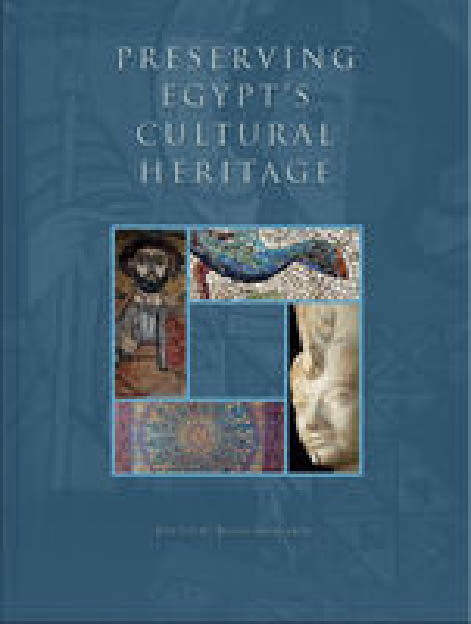 Featured
projects include work on
prehistoric sites in the
Sinai; conserving an early
dynastic funerary
enclosure—one of the
oldest structures in the
world; conserving the
shattered sarcophagus of
Ramesses VI; cleaning
exquisite Greco-Roman
mosaics in Alexandria;
cleaning and conserving
brilliantly colorful
Coptic wall paintings in
the world’s earliest
Christian monasteries;
conserving splendid
Islamic buildings in
Historic Cairo; and the
training of a new
generation of Egyptian
archaeologists. Featured
projects include work on
prehistoric sites in the
Sinai; conserving an early
dynastic funerary
enclosure—one of the
oldest structures in the
world; conserving the
shattered sarcophagus of
Ramesses VI; cleaning
exquisite Greco-Roman
mosaics in Alexandria;
cleaning and conserving
brilliantly colorful
Coptic wall paintings in
the world’s earliest
Christian monasteries;
conserving splendid
Islamic buildings in
Historic Cairo; and the
training of a new
generation of Egyptian
archaeologists.
The book documents these
important projects with
in-depth histories and
over 225 full color
images. It is distributed
by The American University
in Cairo Press and can be
ordered from Amazon here.
Back to
top
|
|
|
|
| |
Copyright © 2009-2021
ARCE/OC. All rights reserved.
|
|
|
|
|